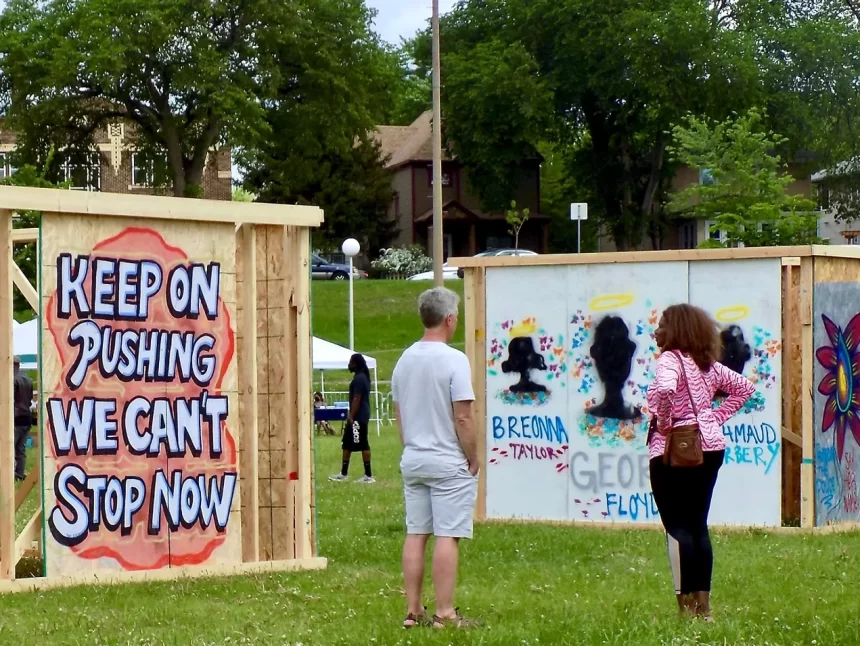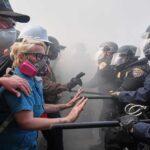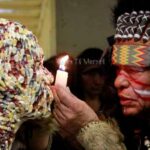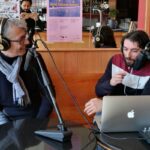Interview with Leesa Kelly of Memorialize the Movement
Laura Thompson
Leesa Kelly is the founder and lead organizer of Memorialize the Movement (MTM), a grassroots organization based in Minneapolis, MN that was created in the wake of George Floyd’s murder by members of the Minneapolis Police Department and the protests that followed on May 25th, 2020. The primary mission of MTM is the collection and preservation of the plywood murals made by 2020 protesters and mourners as a means to both memorialize the moment and build a collective memory of the uprising, protest, and grief that took place in the Twin Cities in 2020. The discussion that is transcribed below took place in the Winter of 2022 between Kelly and FIELD collective member Laura Thompson.
Laura Thompson: You are a community organizer, a writer, and an activist. When you were younger what did you hope to be and at what point was it clear that this was your path?
Leesa Kelly: I grew up on the West Side of Chicago and my family was pretty poor…I went to school for psychology, but I hated it. The program at my school was more research-focused than people-focused, and I very much cared more about helping people than lab rats, which is what was Western Michigan University is known for. I decided to take a semester off and when I went back, I chose tourism as my major and global studies as my minor. At that time, I started to get involved with different RSLs and student organizations doing activist work. As a member of these organizations, we staged protests, die-ins, and flash mobs to raise awareness about various issues that were really important for us. But I still really didn’t know what I wanted to do…When I left college I thought, I’m just going to figure it out. I knew that I was passionate about travel, passionate about reading and exploring, and expanding my worldview. I knew I wanted to go in that direction, but I ended up working in Financial Aid after college…at Walden University. Later, I got a job at Augsburg University in Minneapolis, and I absolutely hated it. I had been thinking about becoming a travel and lifestyle blogger, so after working at Augsburg for six months, I quit and started blogging. I also applied for a job at United Airlines as a flight attendant they hired me. But then COVID happened I was never able to attend the training and they instituted a hiring freeze that they never recovered from. But the blog was going pretty successfully, and I started growing my following quite a bit. Quarantine made me really productive. I was coming up with and churning out material that people were identifying with. But then George Floyd was killed. I stopped blogging and started Memorialize the Movement. It is a total 180 from what I was doing and what I thought my dream job was, but now I can’t see myself doing anything else.
LT: It seems like you were developing all the skills that you have put into MTM, including being about to captivate an audience through social media and other things that draw people together. So, on that note, as the executive director and founder of MTM, could you talk about how you came up with the idea for the organization and how you have developed it over time?
LK: The best way to describe why I founded MTM is that it was a trauma response. You don’t really know what you are doing sometimes until you’ve already done it. That was very much the case with me and the start of the organization. After George Floyd was killed, I was numb, frankly. I couldn’t eat. I couldn’t sleep. I really wasn’t functioning well as a human being. I was just going to protests and going home and crying myself to sleep. Over and over and over. It was a really hard time in my life…But I felt like I just needed to do something.
I already had a very complicated relationship with the city of Minneapolis and Minnesota in general. I have two brothers and three sisters and I’m the oldest. One of my brothers comes here very often to visit family because he has male cousins who are his age. When he was in high school, he would sometimes spend the summer here. This is like a second home to him. One year, he visited when he was about 16. He and my cousins, who the same age, went on the bus to the Mall of America. But the bus was stopped and police got on. They picked him and my cousins out of the crowd. They held guns on them and frisked them in front of everyone, just humiliating them. My brother asked, “What did we do?” And they said, “Oh he fit a description of someone.” I was so mad when I found out about that. I was so disgusted and just terrified for my brother. He’s like my own child because I helped raise him. I just could not imagine being there with him in that situation…So when I was in quarantine blogging and growing green peppers and all sorts of other things, suddenly all I could think about was my brother and that situation and my cousins who are here currently. My brother is back in Chicago and thankfully he didn’t have to be a part of this. But I felt this overwhelming trauma because in that moment when George was killed, he was my brother. He was my dad. He was my cousin. Even though I do not know him personally, the fact that it happened here as I am living here, but I couldn’t do anything about it was devastating. Every time any Black person is killed anywhere in this country, it’s the same feeling. But the fact that it happened here, just down the street from where I lived made it especially tough. I didn’t know how to process that, but I knew that I needed to do something. For me, going out and protesting wasn’t enough. My mutual aid efforts we just a drop in a larger pool. But then the weather started to get nicer, and I started to notice the murals everywhere.
They struck me initially because I couldn’t process what I was feeling. And yet, here were these very eloquent words and phrases and emotions displayed in the form of beautiful murals or really raw, ugly messages. Take them or leave them, they spoke to me because they helped provide language for emotions that I couldn’t describe. I felt that if it was happening for me, then it must be happening for others…They held a sort of spirituality, and they prompted a sense of community. I didn’t feel alone, because other people had written about their experiences and of feeling the same feelings that I felt: the anger, the fear, the grief, the sadness, the loss, the hope, the love. All of these complex emotions were just swirling around inside my head and heart. How do you get that out? There were these people who were brave enough and courageous enough to put it out there into the world because they needed to get it out, and this spoke to me on a deep level.
Before I really considered what I was doing, I reached out to the African American Heritage Museum and Gallery and told them that I was going to collect some murals. I asked them, if I could, would they help me figure out what to do with them. At first, they were like, who are you? But I raised $5,000.00 for the museum to show them that I was serious about it. I’m also part of a group called the Global Shapers, which is a global organization of changemakers under the age of 30. There is a chapter in every major city in the world and we get together and talk about putting together community projects that help improve the communities that we live in. So, I came to the Shakers and told them that I think we should do something and I think this is what we should do. And they agreed. So, I made flyers and created a GoFundMe account. Next thing I knew, I was going door-to-door, talking to businesses, putting up the flyers, and just asking people what they were going to do with the murals. That’s where it branched out from and how I got started. It’s something that I’m still processing. I don’t know how I got started and I don’t know why I decided to do it when this is something I’ve never done before. This is not something that I have the skills to do. But, in the back of my head, I was thinking to myself, “What would you do if this was your brother?” And I just sprang into action.
LT: I read somewhere that you’ve collected over 1000 boards at this point. Are they still in the Northrup King building in Northeast Minneapolis or have you moved to a different space?
LK: This is our last year at the Northrup King building. In August our lease is up and we will have to move out. They were very generous in offering us the space in October of 2020. The reason they offered us the space at such a discounted rate is because they will be eventually renovating that entire section of the building. So, currently we are still at Northrup, and we have all of the murals stored there. That’s also where we operate all of our preservation work currently.
LT: At this point, you have spent so much time with a multitude of these boards. Have you noticed different themes that have emerged from the murals?
LK: There have been several categories that we have been able to identify, and we are working on creating a digital log to put on our website so that everyone can flip through everything that we’ve been able to collect. I have looked at all the data we have been able to gather about each individual’s story. The first category is full of colorful murals that were done by artists. These can be anywhere between two and six panels long. They’re huge. They’re elaborate. And they took time, energy, and effort to complete. They’re colorful, skillful, and just beautifully striking. Then you have murals that span from four to fourteen panels…Some of them are massive and cover large expanses of buildings. These are vibrant and gorgeous and most of them say things like “Justice for George” and “Rest in Peace” and “Community.” They have really positive messages…Because graffiti writers often just use their tag, we don’t know who a lot of them are. And then you have pieces that were created by communities, and this is my favorite category because there may be one person who has some artistic skill who created the outline and then everybody who lives in that neighborhood comes out and contributes it to the creation of this mural. It may be something where someone drew an outline of a butterfly and then everyone signed their name in it or signed the name of someone who’s been killed by police violence or as a result of police violence. There are so many different forms of handwriting and different materials that were used, like spray paint, marker, pencil, pen, or Sharpie.
You can also tell that there were children and older people who participated in the contribution. Sometimes, you can tell when the person is white or Black because they’ll say things like “We stand with you.” These messages are so raw and powerful. There are also the really broad messages that tend to be a favorite of those in the art preservation field because they were created largely by protesters and individuals who had something specific to say. These are not pretty or colorful and mostly they are unfinished, meaning that they are on a plain plywood background. Most of them weren’t painted ahead of time. They are just a bit of spray paint or Sharpie or marker. These are really emotional messages that are electrically charged. You can tell from the spirit of those murals that they were created in a split second. Not with a week’s time or with the participation of a loving community. They were created in trauma. Those are some of the main categories that we have. There are a lot of subcategories including a ton of portraits of George Floyd and there are many messages that speak to other people who were killed in 2020, 2019, or 2018. There’s a lot of messages about police accountability…In 2021, we collected one from on a French store front. It’s one of the only international murals that we have in that it has a lot of different languages on it. They all say things like peace and love and solidarity in French and Italian.
LT: It sounds like MTM has partnered with so many different incredible organizations. You already talked about the Minnesota African American Heritage Museum and Gallery, but you also work with Save the Boards and Visual Black Justice. Do you view partnering with other organizations and creating events as like a key aspect to MTM?
LK: Yes, coalition building is a huge pillar of Memorialize the Movement, because this isn’t just about me, or us, or an organization. This is about how we can contribute to the larger movement. I recently learned about the idea “ecosystem of justice” in which everyone has a job to do. In this system, we create change as long as we are all doing our part and supporting each other’s roles. For me, I think that it’s so important that we continue to partner with other community organizations, because everyone has got to do something to ultimately move the mission forward. Memorialize the Movement focuses on preservation of the murals, accessibility to, and visibility of the murals. The Urban Art Mapping team is recording data not just from Minneapolis, but data from all over the world documenting murals that have been collected or have become permanent fixtures on buildings. There are other organizations like the George Floyd Global Memorial at George Floyd Square. Their job is to preserve that space and continue to hold it so that his story continues to be told and his legacy is not forgotten. Then you have organizations like Render Free, which is a Black woman owned and operated co-working space and healing space here in Minneapolis. It’s for self-identified women of color and their job is to hold space for us, so that when we’re burnt out and when we’re tired, or just need to be in a community with other Black and Brown women, we have a place to go. That’s where I go to work. A lot of other women who have memberships are either entrepreneurs or activists and organizers who are constantly dealing with the stress of the world. When we step into that space, we can let it all go. So, everyone has a job to do. It’s not up to any one person or one organization to move the Civil Rights movement forward or to move Black Lives Matter forward. It’s up to all of us.
LT: I was reading about how you are bringing these boards back into the public space. You co-curated Crossroads: The Watermill Center Summer Festival as well as the public exhibition “Justice for George: Messages from the People” in Phelps Field Park. Could you talk about that experience and if you are working on developing other exhibitions?
LK: Yes. Honestly, those two experiences were two of the best moment of my life. I’ve never curated anything before, so to curate two massive exhibits—one in partnership with Carrie Mae Weems—was amazing. They were very proud moments for me personally, but also for the Memorialized the Movement as a whole. Because people really do identify with these murals, they care about the messages on them. I like to say that the murals are alive with the spirits of the people who created them. And it’s true because when you walk into our space at the Northrup King building there is an instant energy that you feel just deep within, because they are very much alive. Sometimes when you’re holding onto trauma in your body, you need to expel it. So, when people were writing these messages, they were getting things out that they needed to release in order to function on a day-to-day basis. When we put together these large exhibits, we allow people to come back into these spaces, these safe spaces that we created for people to interact with the murals… It was an opportunity for people to reflect. It wasn’t until 2021 that we were able to sit down, take a deep breath, and say what the hell happened last year? A lot of people were just in this blur of action and frenzy, dealing with elections and protests and Pandemic. A lot of us didn’t get an opportunity to properly process what we experienced in 2020. So, creating those spaces gave people that opportunity to sit down and just breathe, to just be and reflect on everything that they experienced last year and come to terms with it. My favorite part of those exhibits was providing the opportunity for people to grow and learn by creating a space where they could feel angry, uncomfortable, and sad. Those emotions could then be channeled into positive actions. That’s what my hope is when we do any event: that people will come into the space and learn, and then channel what they learned into positive action that can lead to real change.
The Minneapolis exhibit “Justice for George” was obviously much needed for the community here after everything we have been through, but the Watermill Center exhibit in New York was phenomenal because it gave an entirely different community of people the opportunity to learn about what we went through and to see the uprising from a new perspective, from our perspective being in ground zero. This was important because they didn’t understand how real it was for us until they saw the murals and learned the context behind them. At Watermill, the exhibit was open to the public for the entire month, but during that time there was a two-day event. Carrie Mae Weems brought in a ton of artists from all over the country who are well-renowned and just let them do their thing. It benefited both Memorialize the Movement and the Watermill Center to continue their Artist-in-Residency program, but the entire time I was there, people were just wandering in and walking around the MTM exhibit and saying that they were so cool: “These are from Minneapolis, right?” Then they asked who the artists were so they could follow, support, or buy their work. It was then that I told them, that one was done by a child, and that one was done by a community of people, and that one was done by a protester. It surprised them that the MTM murals weren’t all done by well-known artists. They were just done by ordinary people. When I explained to them the context of the actual situation in Minneapolis, I could see their faces change. And the realization dawned on them that this is not a pretty story. It’s a real story of a city dealing with horrible trauma in real time and using the plywood as a way to express that trauma so that they can continue to function in their day-to-day lives. I watched them understand where we’re coming from and then that dawning turned into this new electricity. They wanted to get involved.
LT: Are you envisioning having more of these exhibits in other cities? Is that something that is important to the MTM?
LK: Yes. We want to continue to do traveling exhibits in other states. It’s probably something we won’t get to until 2023, because this year we’re doing a lot of capacity building. I’m structuring the organization and trying to build it out into something that can sustain itself long term, which we didn’t get an opportunity to do in 2021. Last year, MTM participated in ten events. We only had two months where we didn’t do any events. So, we didn’t get the chance to start to lay a foundation for the organization or long-term fundraising. Everything we did was for the events that we had in the moment. Our main goal this year is to obviously find a new space to move into come August when we have to be out and then we are going to do “Justice for George” again this year. That will be our second annual and then we have a couple other large events that we’re going to be doing in partnership with some institutions and organizers here, which is very exciting. For example, we will be partnering with the Franconia Sculpture Garden to do an exhibit on their grounds. They have been extremely supportive of the work that we do. Initially in 2020, we said that we would not work with any white owned institutions. And frankly, I think that ideology was a little naïve. What I meant by this was that we would not allow any other institution to do the work that we are doing. We are the storytellers. We are the conservators. We are the ones doing the preservation work to care for the murals. We are the stewards of the boards. When I said that in 2020, I meant that we would not allow any other institution to take over that work. I still very much mean that… But we’re going to do an exhibit on Franconia grounds because they’re the first institution in Minneapolis to reach out to us and offer their support. I met with their executive director Ginger Shulick Porcella and she offered us their space, which is nice because they have the room and we have the murals. It is also important to us to be able to spread them out to give people an opportunity to walk around them…We could see it as we were brainstorming and talking about what it will look like. We are doing it for Día de Muertos because we were talking about the resemblance between the way we have been creating these memorials here in Minneapolis to mourn George Floyd and the way that Mexican people create these memorials for their dead as well. So, that is how the exhibit is going to talk about how and why we remember and the cultural context around that.
LT: Lastly, is there anything you would like to talk about that I haven’t touched on that you would like to address?
LK: I can talk for days about Memorialize the Movement, our success as an organization, all that we’ve been able to accomplish, and how it started as a response to trauma. But I have a larger passion to make sure that the story continues to be told. But what I don’t often talk about is what it takes to do this work. And it takes a lot. People look at nonprofit organizations and think about the incredible work being done. But a lot of the time, they forget to ask what it takes to do that work. Frankly, we’re at the point that as we continue to build and take stock of all of our assets, that we realized we’re struggling as an organization. We are now one of those struggling nonprofits. We need resources, to be able to put on a second annual exhibition. The exhibit that we did last year was a huge success. In order to replicate that, we need funding. And then this August we are moving out of our space into a temporary semi-permanent space… In our case, we are looking into warehouse space on the scale that we need in order to be able to continue our programming and continue to preserve the murals adequately and build out the organization in order to create this sustainable entity that can build out its own institution and teach people how Black and Brown people preserve their own history and their own historical artifacts. In 2020, we had an outpouring of love and support and resources to help us achieve what we did in 2021. But now it is two years past and we still need resources and funding. In order to continue this work, we don’t just need people to remember George Floyd’s name and remember what happened with the uprising of 2020, we need people to continue to act and support us actively by donating and contacting us to offer support. We would like to sustain this organization so that the murals can be preserved for 20, 50, 100 years, because that’s the goal, right? The goal is never just to have an exhibit every year. The goal is to preserve the murals so that 50 years from now, when someone’s grandchild asks what the Minneapolis protests of 2020 were or what the Minneapolis uprising was, people can say, let’s go to the museum and then I’ll tell you all about it.
LT: Leesa Kelly, thank you so much for taking the time to talk about your work with MTM.
Leesa Kelly is an activist, writer, public speaker, and curator. Leesa is the Founder and Executive Director of Memorialize the Movement, a grassroots organization that preserves, displays, and educates the public on the protest plywood murals that emerged after George Floyd’s death in Minneapolis in 2020. Through her work with Memorialize the Movement, Leesa has spoken at over 17 conferences and universities, organized large-scale exhibitions in the Twin Cities and New York, and has led workshops on cultivating BIPOC representation and visibility in the museum and conservation industry. She believes in dismantling oppressive systems and rebuilding new systems that work for ALL people.
Laura Thompson is a Ph.D. student in Art History, Theory, and Criticism at the University of California, San Diego and a member of FIELD’s editorial collective.







